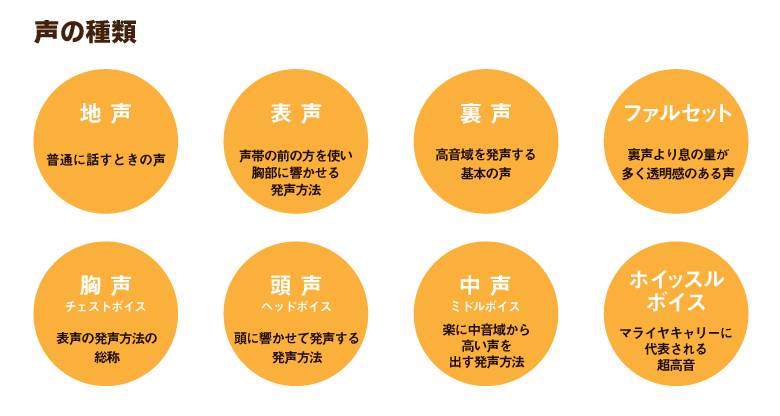Q: I can't sing as high voice as I want. I would like you to teach me how to put out a falsetto easily, and the basics of vocalization.
A: "I can't sing high notes"
This is a question from so many people.

First of all, there are different types of voices, which can be broadly divided into "frontal voice" and "falsetto".
Many people often think that "chest voice" = "frontal voice", but "chest voice" and "frontal voice" are different.
Explained in an easy-to-understand manner, please understand that the usual speaking voice is "chest voice".
Strictly speaking, "spoken falsetto" and "singing falsetto" are different.
A "Singing Falsetto" has a larger amount of breath than "spoken falsetto".
"You can't sing with just your voice"
"I want to sing in a high register, but I can't sing because it's high."
So many people are concerned about getting a high-pitched voice.
Basically, the treble range is sung in "falsetto".
If you use falsetto well, you can sing a wide range of songs, and you can also sing KEY songs with a high range.
However, some say "I don't know how to make a falsetto".
I have many inquiries such as "If I try to make a falsetto, it is weak".
Such a falsetto can be mastered relatively easily if you learn the knack.
What is the difference between spoken falsetto and singing falsetto?
A "Singing Falsetto" has more breath than a "spoken falsetto", and it is a transparent voice.
The voice when speaking normally is the "chest voice".
"Voice" is a vocalization method that uses the front part of the vocal cords to resonate with the chest, and is called the "chest voice."
Even if you have a limited ranged singing voice with only "chest voice", you can sing high frequencies relatively easily if you use a falsetto well.
This will increase your repertoire of songs that you can sing, and will help you increase expression techniques.
In addition, learning falsetto is an important point in order to improve voice control.
Actually, there are several types of falsetto, and there is a vocalization method that has a small amount of breath and can produce a relatively large amount of voice. It is called a "head voice" that echoes in your head.
In order to master the head voice, you need to be able to speak falsetto cleanly.
Furthermore, in order to be able to sing super high tones such as "whistle voice" represented by Mariah Carey, training of "falsetto" is required first.
In addition, let's learn "falsetto" in order to master vocal skills such as "middle voice" that easily produces a high voice from the midrange.
Why you can't sing falsetto
Even if you try to sing falsetto, there are many people who feel that they cannot sing well, as they are unable to control their voice well or their voice fades. In particular, many men are not good at it.
First of all, getting to know the mechanism of voice is the fastest way to improve your skills.
There are two folds in the "vocal cords". Think of them as two strings.
When this vocal cord is closed, you can breathe between the strings and the strings collide with each other, causing the vocal cords to vibrate and produce sound. This is the "voice".
When uttering a strong, firm "voice", the muscles called the obturator muscles that close the vocal cords go to work. The voice is strong and fat because it attacks the vocal cords strongly. (Often used for vocalization in the relatively low range.)
On the other hand, with the falsetto, the muscle called cricothyroid muscle that stretches the vocal cords goes to work, and the force to close the vocal cords is weakened. The vocal cords are in a stretched state (thin strings like a 1st string), and vocalization becomes weak and thin.
If the obturator muscles that close the vocal cords during vocalization are used strongly, falsetto will be difficult to put out. Let's practice how to make a voice while being aware of such muscle movements, as well as how to shake the vocal cords.

3 tips to get a clean falsetto
1. Sing with abdominal breathing
First, let's master abdominal breathing, which is the basis of singing and vocalization.
Abdominal breathing not only increases voice volume but also has a relaxing effect. When practicing vocalization, first do "abdominal breathing".
When speaking, if the muscles of the tongue, vocal cords, and face are strong, the muscles will become lumpy and the vocal cords will become stronger and close more easily. First of all, relax with extra power.
2. Speak to the head
Shape your mouth into an "O" shape and say "FU" to breathe out.
You don't have to make a loud voice, so get a feel for it first.
3. Open your throat
With a continuation of that feeling, the tongue (tongue base) is further lowered. It will be easier to put out falsetto if you understand the feeling of opening your throat.
Let's practice making sounds such as "fu" and "ho" by combining the consonants "F" and "H" and the vowel "U", which easily open vocal cords.
In conclusion
In fact, there are many people who want to sing with just their voice.
However, if you continue to sing with just your voice, your throat will get tired easily, and in some cases it may cause damage.
Falsetto training is also a skill to acquire how to use the throat and control the pharynx, and it is an important technique required to master the technique of singing well.
If you want to be sing well, falsetto is definitely an ability you want to acquire.
If you feel the limits of your own voice training, consider getting professional guidance.
Find a voice trainer that suits you.


























